Investigating Resiliency of Transportation Network Under Targeted and Potential Climate Change Disruptions
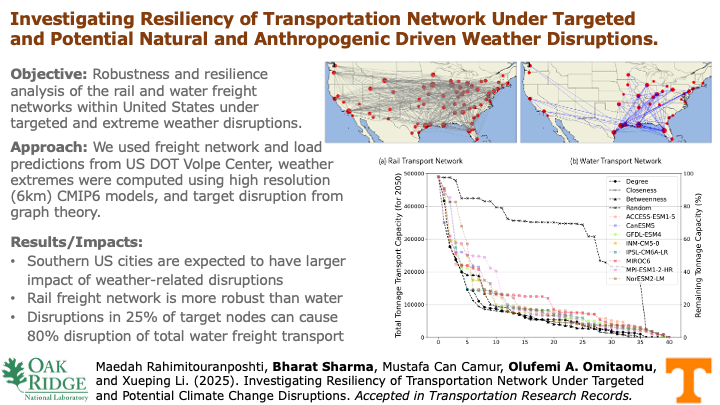 Authors: Maedah Rahimitouranposhti, Bharat Sharma, Mustafa Can Camur, Olufemi A. Omitaomu, and Xueping Li
Authors: Maedah Rahimitouranposhti, Bharat Sharma, Mustafa Can Camur, Olufemi A. Omitaomu, and Xueping Li
Abstract: Ensuring robustness and resilience in intermodal transportation systems is essential for the continuity and reliability of global logistics. These systems are vulnerable to various disruptions, including natural disasters and technical failures. Despite significant research on freight transportation resilience, investigating the robustness of the system after targeted and climate-change driven disruption remains a crucial challenge. Drawing on network science methodologies, this study models the interdependencies within the rail and water transport networks and simulates different disruption scenarios to evaluate system responses. We use the data from the US Department of Energy Volpe Center for network topology and tonnage projections. The proposed framework quantifies deliberate, stochastic, and climate driven infrastructure failure, using higher resolution downscaled multiple Earth System Models simulations from Coupled Model Intercomparison Project Phase version 6. We show that the disruptions of a few nodes could have a larger impact on the total tonnage of freight transport than on network topology. For example, the removal of targeted 20 nodes can bring the total tonnage carrying capacity to 30 percent with about 75 percent of the rail freight network intact. This research advances the theoretical understanding of transportation resilience and provides practical applications for infrastructure managers and policymakers. By implementing these strategies, stakeholders and policymakers can better prepare for and respond to unexpected disruptions, ensuring sustained operational efficiency in the transportation networks.
Paper: TRR (2025)
Carbon cycle extremes accelerate weakening of the land carbon sink in the late 21st century
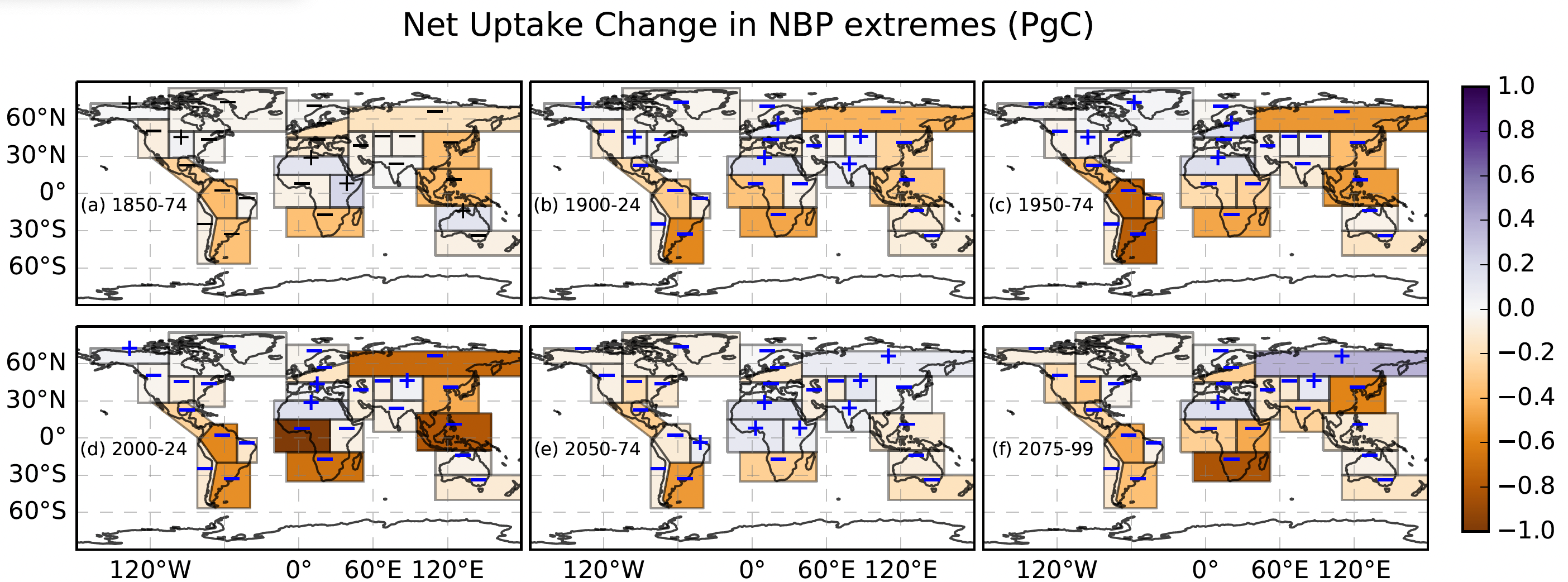 Authors: Bharat Sharma, Jitendra Kumar, Auroop Ganguly, and Forrest M. Hoffman
Authors: Bharat Sharma, Jitendra Kumar, Auroop Ganguly, and Forrest M. Hoffman
Abstract: Increasing surface temperature could lead to enhanced evaporation, reduced soil moisture availability, and more frequent droughts and heat waves. The spatiotemporal co-occurrence of such effects further drives extreme anomalies in vegetation productivity and net land carbon storage. However, the impacts of climate change on extremes in net biospheric production (NBP) over longer time periods are unknown. Using the percentile threshold on the probability distribution curve of NBP anomalies, we computed negative and positive extremes in NBP. Here we show that due to climate warming, about 88 % of global regions will experience a larger magnitude of negative NBP extremes than positive NBP extremes toward the end of 2100, which accelerate the weakening of the land carbon sink. Our analysis indicates the frequency of negative extremes associated with declines in biospheric productivity was larger than positive extremes, especially in the tropics. While the overall impact of warming at high latitudes is expected to increase plant productivity and carbon uptake, high-temperature anomalies increasingly induce negative NBP extremes toward the end of the 21st century. Using regression analysis, we found soil moisture anomalies to be the most dominant individual driver of NBP extremes. The compound effect of hotness, dryness, and fire caused extremes at more than 50 % of the total grid cells. The larger proportion of negative NBP extremes raises a concern about whether the Earth is capable of increasing vegetation production with a growing human population and rising demand for plant material for food, fiber, fuel, and building materials. The increasing proportion of negative NBP extremes highlights the consequences not only of reduction in total carbon uptake capacity but also of conversion of land to a carbon source.
Paper: Biogeosciences (2023)
Highlights: EESM Project Highlights
Quantifying Carbon Cycle Extremes and Attributing Their Causes Under Climate and Land Use and Land Cover Change From 1850 to 2300
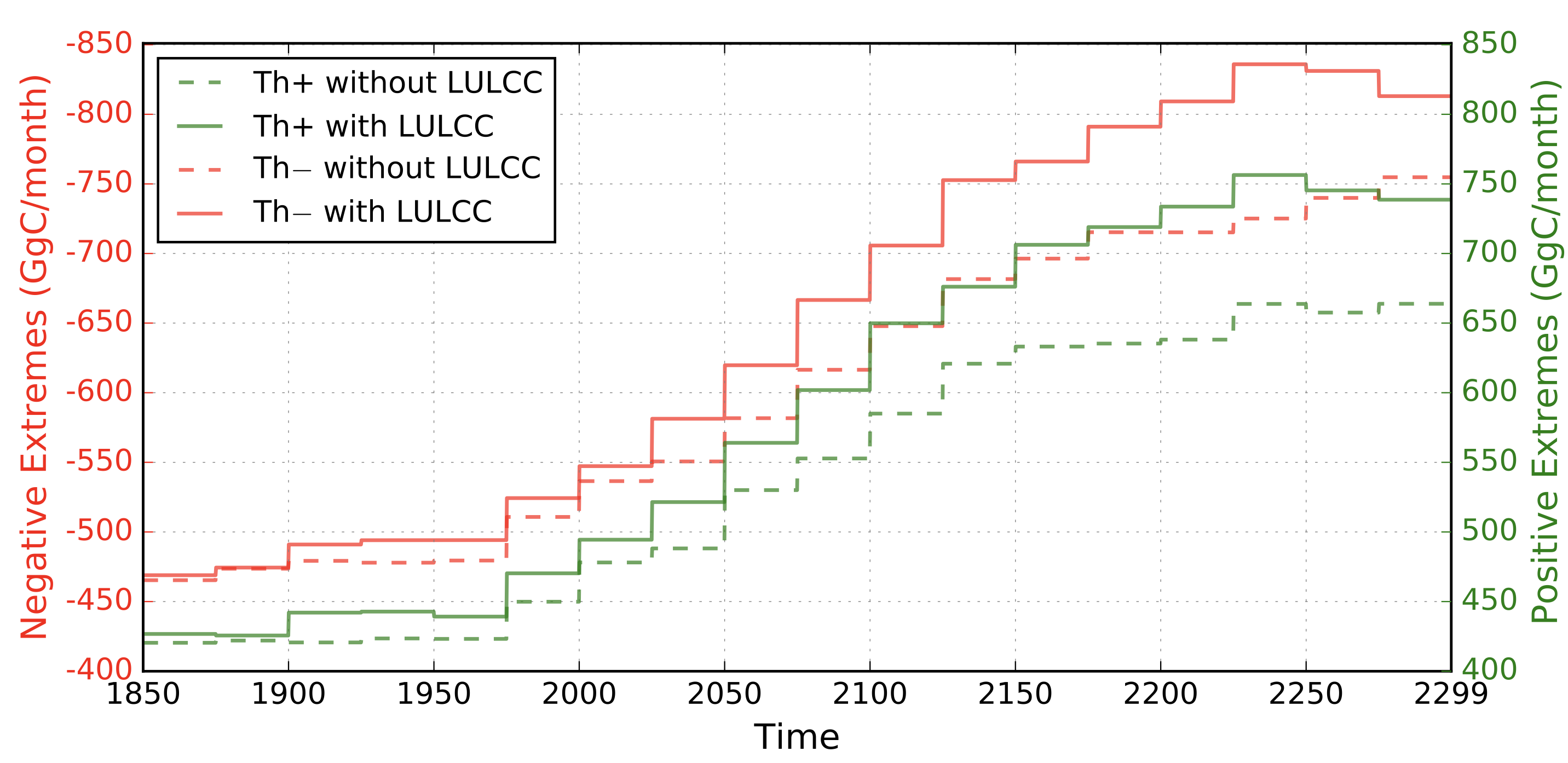 Authors: Bharat Sharma, Jitendra Kumar, Nathan Collier, Auroop Ganguly, and Forrest M. Hoffman
Authors: Bharat Sharma, Jitendra Kumar, Nathan Collier, Auroop Ganguly, and Forrest M. Hoffman
Abstract: The increasing atmospheric carbon dioxide (CO2) mole fraction affects global climate through radiative (trapping longwave radiation) and physiological effects (reduction of plant transpiration). We use the simulations of the Community Earth System Model (CESM1-BGC) forced with Representative Concentration Pathway 8.5 to investigate climate-vegetation feedbacks from 1850 to the year 2300. Human-induced land use and land cover change (LULCC), through biogeochemical and biogeophysical processes, alter the climate and modify photosynthetic activity. The changing characteristics of extreme anomalies in photosynthesis, referred to as carbon cycle extremes, increase the uncertainty of terrestrial ecosystems to act as a net carbon sink. However, the role of LULCC in altering carbon cycle extremes under business-as-usual (continuously rising) CO2 emissions is unknown. Here we show that LULCC magnifies the intensity, frequency, and extent of carbon cycle extremes, resulting in a net reduction in expected photosynthetic activity in the future. We found that large temporally contiguous negative carbon cycle extremes are due to a persistent decrease in soil moisture, which is triggered by declines in precipitation. With LULCC and global warming, vegetation exhibits increased vulnerability to hot and dry environmental conditions, increasing the frequency of fire events and resulting in considerable losses in photosynthetic activity. While most regions show strengthening of negative carbon cycle extremes, a few locations show a weakening effect driven by declining vegetation cover or benign climate conditions for photosynthesis. Increasing hot, dry, and fire-driven carbon cycle extremes are essential for improving carbon cycle modeling and estimation of ecosystem responses to LULCC and rising CO2 mole fractions. Moreover, large aberrations in vegetation productivity represent potential and growing threats to human lives, wildlife, and food security.
Paper: JGR Biogeosciences (2022)
Highlights: EESM Project Highlights
Using Image Processing Techniques to Identify and Quantify Spatiotemporal Carbon Cycle Extremes
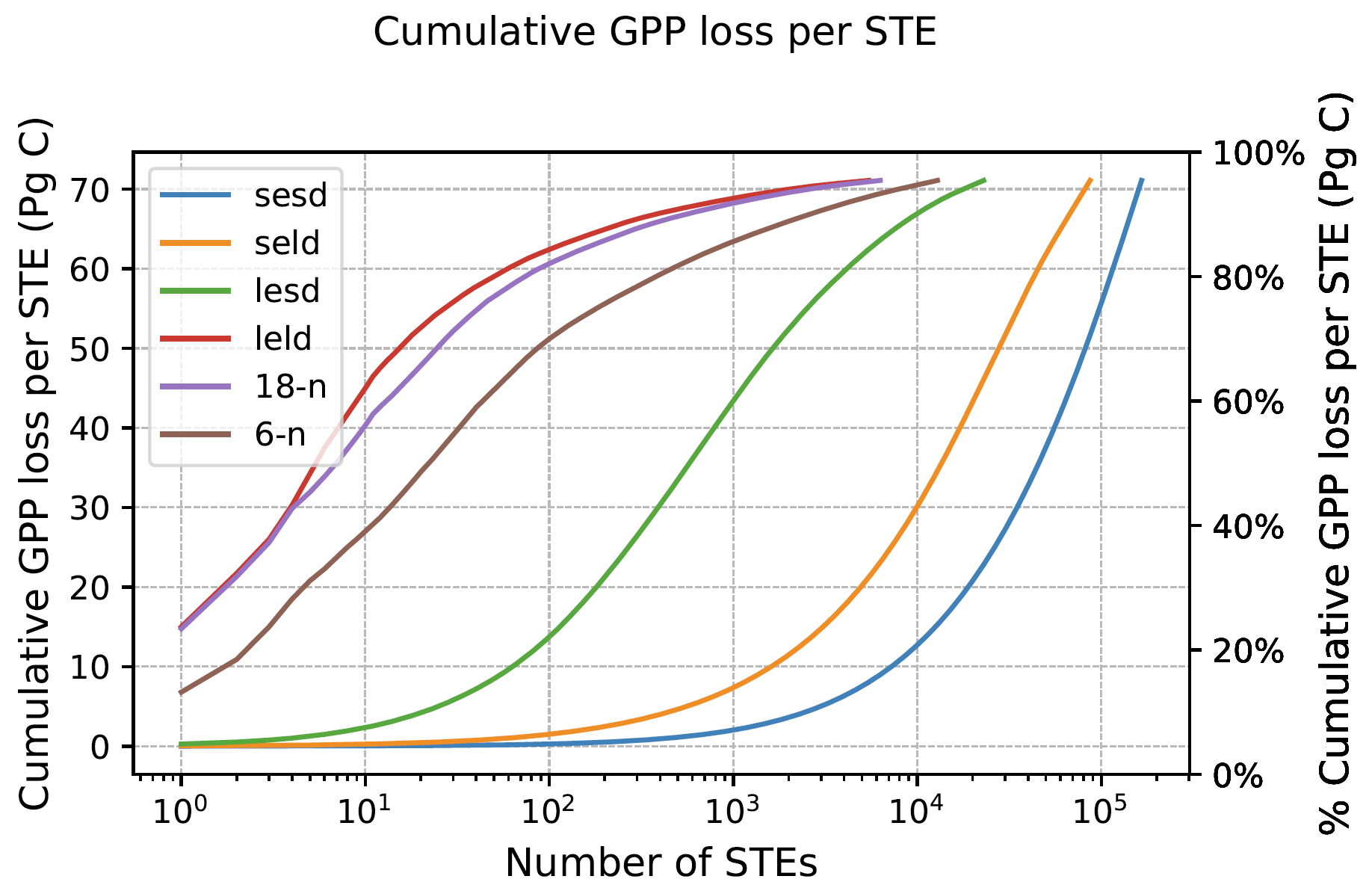 Authors: Bharat Sharma, Jitendra Kumar, Auroop Ganguly, and Forrest M. Hoffman
Authors: Bharat Sharma, Jitendra Kumar, Auroop Ganguly, and Forrest M. Hoffman
Abstract: Rising atmospheric carbon dioxide due to human activities through fossil fuel emissions and land use changes have increased climate extremes such as heat waves and droughts that have led to and are expected to increase the occurrence of carbon cycle extremes. Carbon cycle extremes represent large anomalies in the carbon cycle that are associated with gains or losses in carbon uptake. Carbon cycle extremes could be continuous in space and time and cross political boundaries. Here, we present a methodology to identify large spatiotemporal extremes (STEs) in the terrestrial carbon cycle using image processing tools for feature detection. We characterized the STE events based on neighborhood structures that are three-dimensional adjacency matrices for the detection of spatiotemporal manifolds of carbon cycle extremes. We found that the area affected and carbon loss during negative carbon cycle extremes were consistent with continuous neighborhood structures. In the gross primary production data we used, 100 carbon cycle STEs accounted for more than 75% of all the negative carbon cycle extremes. This paper presents a comparative analysis of the magnitude of carbon cycle STEs and attribution of those STEs to climate drivers as a function of neighborhood structures for two observational datasets and an Earth system model simulation.
Paper: IEEE ICMDW (2022)
Resilience in Urban Areas : An Approach to Study Interaction between Evacuation and Land Use & Transportation Structures
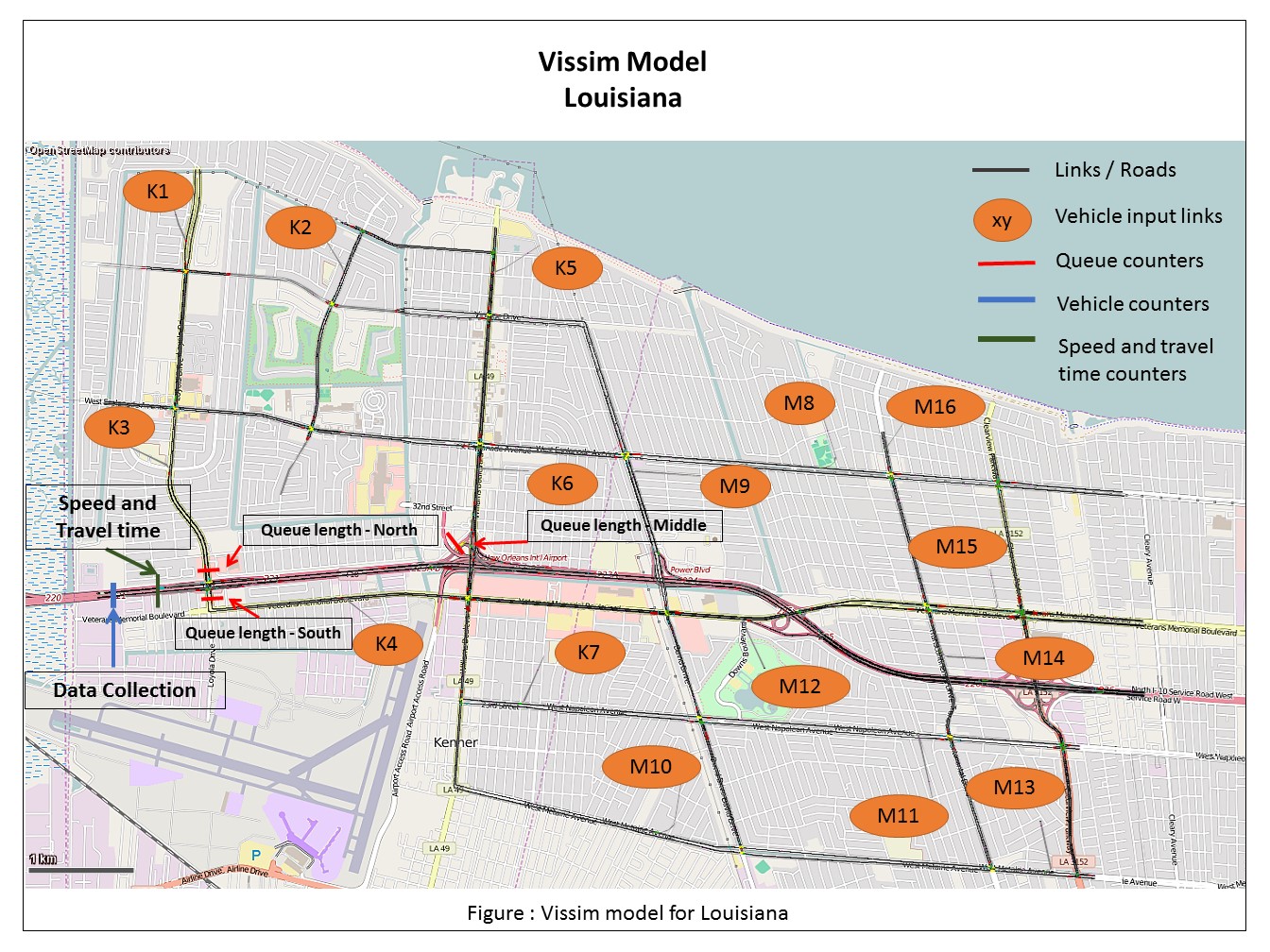
Authors: Bharat Sharma and Benjamin Buettner
Abstract: The usage of the word resilience in the last decade has tremendously increased in several fields, including the field of urban planning. Generally understood as capacity to absorb and bounce back; resilience aims to prepare a person or a city for uncertainties, shocks, and stresses.
The development of urban structure varies across the world. Recently increased awareness regarding environmental and air quality has attested the advantages of Transit Oriented Development over Transit Adjacent or Automobile-Oriented devel- opment.
In this thesis, an attempt to analyze the response of cities with different land use structure when stuck with warning based disaster has been made. Therefore, same transport infrastructure and supply has been modeled so as to generate results close to the reality. Different parameters - for instance, evacuation time, queue lengths, vehicle travel time, average delay time, and average speed - were analyzed.
The quantitative analysis using VISSIM 7 software confirmed the hypothesis that transit oriented developments if faced with a shock, perform better than car dependent city structure.
Report: Master Thesis (2016)
Simulation: Congestion on Evacuation Paths
Characteristics of Soil, Sand, Fly ash, and Ceramix Mix for Use as Subgrade Material
Authors: Bharat Sharma, Abhishek Sharma, Tushar Khandelwal, Neelmani Singh, Ashish Parmar, and R. K. Sharma
Abstract: The most concerning problem today with the Thermal power plant is the disposal of Fly ash. The use of Fly ash as landfill causes great environmental pollution like, groundwater contamination, since coal contains trace levels of heavy metals. Similarly, waste ceramic too causes great environmental problem. So, there is a need to utilize these materials by exploiting their inherent properties to solve the environment and disposable problem. This report brings out the results of an experimental programme carried out to evaluate the effectiveness of using Fly ash with randomly distributed discrete waste ceramic for soil stabilization by studying the compaction and strength characteristics for use as subgrade material. The influence of different mix proportions of Clay, Sand, Fly ash and Ceramic on compaction, drainage and CBR values has been studied. The results show that addition of Fly ash increases the OMC and decreases the MDD, but increased the CBR. The designed composite may be used effectively for construction of subgrade, embankment and foundations of low cost roads.
Report: UG Major Project 2 (2012)
Journal Publication: Recent Trends in Civil Engineering & Technology (2013)*
Comparitive Analysis of Commercially Available Software Tools for Slope Stability and Simulation of Dynamic Loading
Authors: Bharat Sharma, Abhishek Sharma, Rounak Maheswari, Tushar Khandelwal, and R. K. Sharma
Abstract: Analysis of slope stability is carried out to identify the most critical failure plane so as to minimize the occurrence of slope failures and landslides. It is always needed to give serious consideration before any construction or development is executed to ensure that the designed slopes remain stable. Slope failure can be determined through appropriate measurement of slope stability. In this study C-programming and GEO4 and Plaxis 2D software have been used to determine the factor of safety of the selected slope. Total station surveying has been used to prepare contour maps of the study area using LISCAD. The parameters such as soil cohesion (c), angle of internal friction (φ), and unit weight of soil (γ) have been determined using laboratory experiments. The site is modeled as multilayer so as to simulate real conditions as close as possible. The simulation involving dynamic loading as the site is subjected to mild earthquakes is also incorporated. The study is conducted for a site where the mode of failure is analyzed using Bishop’s method and appropriate preventive measure for slope stability is recommended and detailed design is provided.
Report: UG Major Project 1 (2011)
Journal Publication: Recent Trends in Civil Engineering & Technology (2013)*
Selected Class Projects
Investigating Resiliency of U.S. Airlines Network (2016) by Bharat Sharma and Lizzy Warner.
Overview of Public Transportation in the City Chandigarh, India (2015) by Bharat Sharma
Dynamics of Air Transport: There is more to it than just Flying (2014) by Bharat Sharma
Third Runway at Munich Airport: Planning, Protests and Progressn (2014) by Bharat Sharma
Accessibility to Primary Education with respect to Fuel Price Hikes (2014) by Bharat Sharma
Congestion Pricing in the city of London (2014) by Bharat Sharma, Aslam Zuhair, Karakikes Ioannis, Karatsoli Maria, Keen Umair Hamid, and Politi Stamatia
* Name changed in 2016